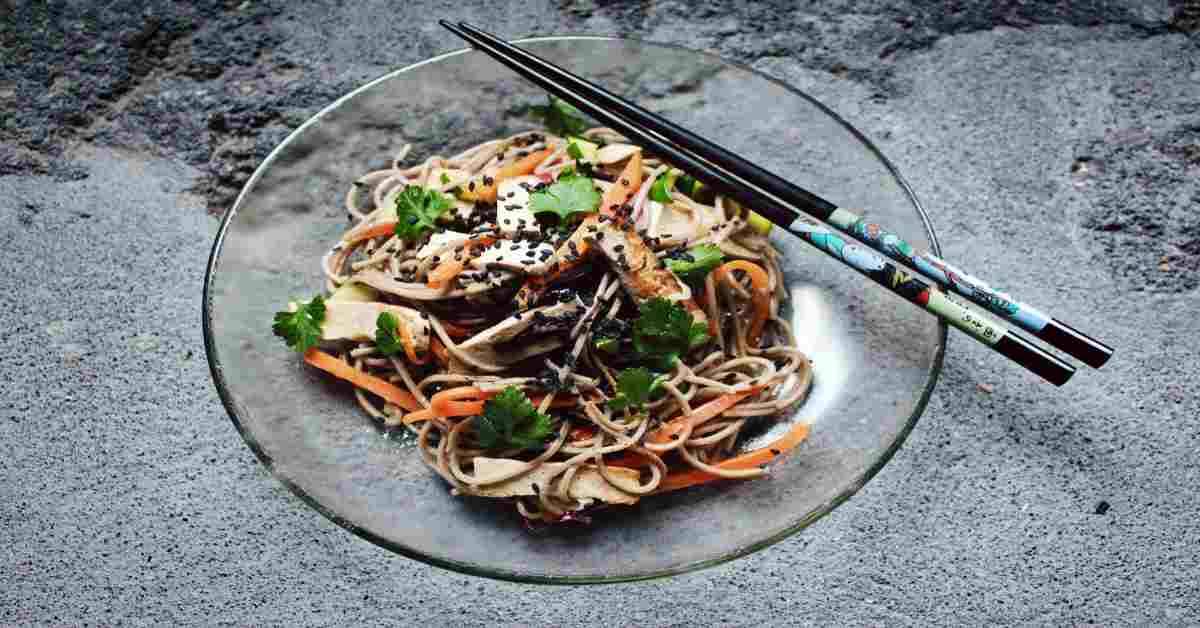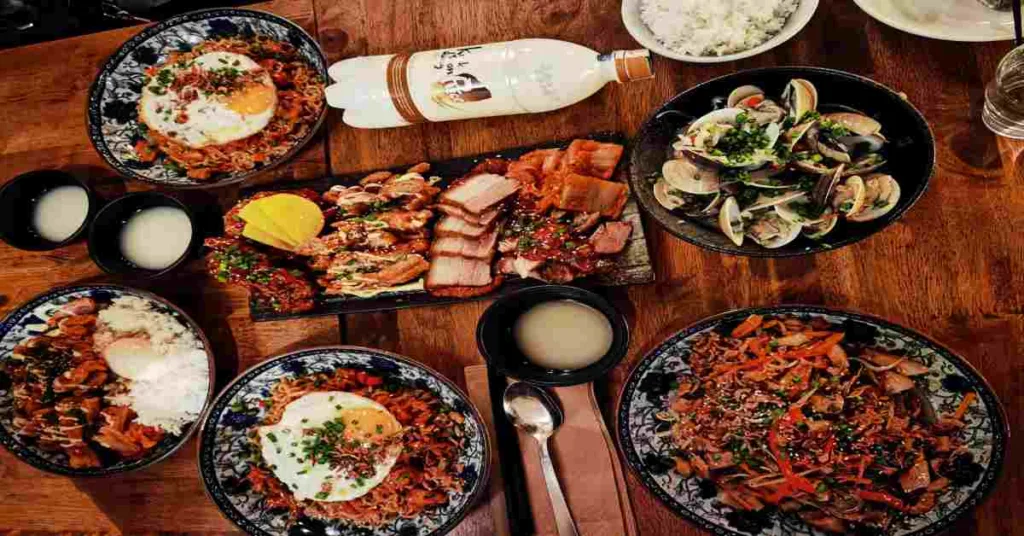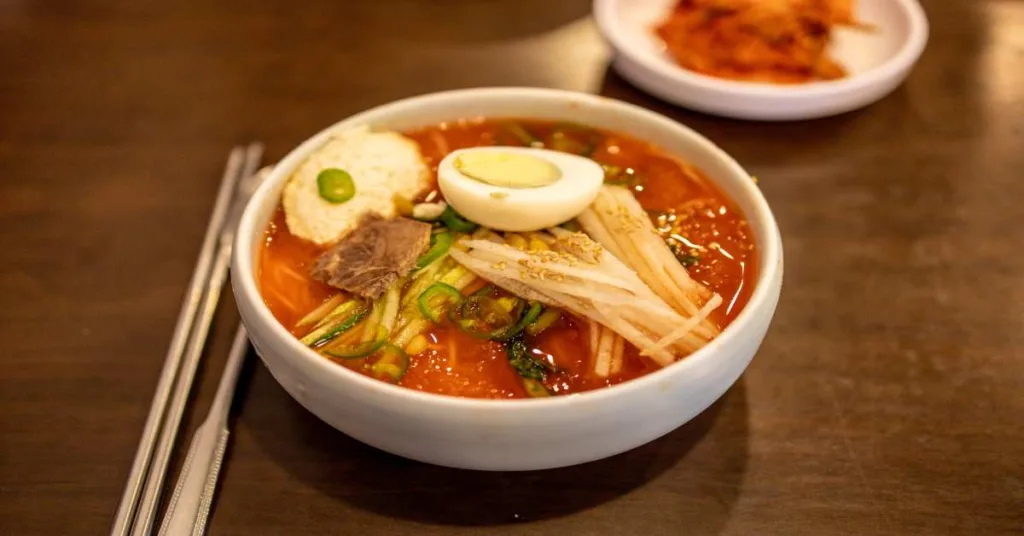Korean Black Bean Noodles (jjajangmyeon) are the most popular food for home delivery in Korea, just like pizza delivery is in America, as you may have seen in Korean dramas. On a frantic moving day, Koreans order this dish. Try this nourishing noodle dish when you need a quick lunch that won’t break the bank.
Contents:
- What are Korean Black Bean Noodles (Jajangmyeon)?
- What is Black Day in Korea?
- Varieties of Korean Black Bean Noodles
- Which noodles are best for Korean Black Bean Noodles (Jjajangmyeon)?
- Korean Black Bean Noodle’s Recipe
- What to serve with Korean Black Bean Noodles (Jjajangmyeon)?
- How do store & reheat Korean Black Bean Noodles (Jjajangmyeon)?
What are Korean Black Bean Noodles?
Korean Black Bean Noodles is a fusion dish of Korean and Chinese cuisine that uses thick handmade wheat noodles and is topped with raw cucumber slices, chunjang (salty black soybean paste), chopped pork, and veggies. It is often spelled jjajangmyeon. There are various variations of Korean Black Bean Noodles that use beef and other seafood.
It’s simpler than you might think to make these tasty black noodles at home. Before McDonald’s or Pizza Hut brought pizza to Korea, there was a noodle dish called “Jjajangmyeon, the Korean noodles with black bean sauce,” which changed Korean children’s palates from kimchi pancakes to pizza.
The Jjajangmyeon recipe originally comes from China, and in the early 1900s, Chinese traders brought it to Korea. The first Jajangmyeon that is formally recognized from a restaurant called Gonghwachun in Incheon, Korea’s Chinatown, back in 1905. In Korea, the original Chinese black bean noodles underwent a modest evolution, and they quickly gained enormous popularity among Koreans.
It’s a well-known Korean-Chinese food, along with tangsuyuk (sweet and sour pork or beef) and jjamppong (spicy seafood noodle soup). It plays a significant role in Korean cuisine.
In the past, jjajangmyeon was the all-time favorite cuisine of Korean children. Korean parents treat their children to Jajangmyeon on major occasions like graduation, test days, birthdays, etc. Every kid’s favorite food was it! Still, it is most likely. Every Korean who is over 30 finds it to be a comfort dish.
It is consumed by Koreans on Black Day.
You may like to know – Bibim Naengmyeon (Korean Spicy Cold Noodles)
What is Black Day in Korea?
Korean Black Day is a special day when single individuals who didn’t receive any gifts or presents on Valentine’s Day (14 February) or White Day (14 March) gather together, eat these noodles with a black bean sauce (Jajangmyeon), and commiserate with one another. Every April 14th, it takes place.
Jajangmyeon, a more modern phenomenon, has evolved into a symbolic dish that single individuals share with their friends on Black Day (April 14) to commiserate about the lack of a loving partnership over bowls of Korean Black Bean Noodles.
Varieties of Korean Black Bean Noodles
Jjajangmyeon comes in five different variants, all of which are delectable on their own in Korea.
- Korean Black Bean Noodles: The most typical variety of Jajangmyeon that you can find in restaurants is this normal variety, sometimes referred to as old-fashioned (Yetnal). Due to the addition of a liquid ingredient, the Jajang sauce has more liquid than the Chinese version of black bean noodles. At the end of cooking, cornflour is used to thicken the sauce.
- Ganjjajangmyeon: If you order this dish in a restaurant, it will cost a little bit more than the standard Korean Jajang dish. The sauce is drier and has chunkier components because there is no additional liquid.
- Samseon Jjajangmyeon: Samseon literally translates to “fresh delights from three sources”(land, sea, and sky), but in Korean-Chinese cooking, it most often refers to a dish featuring a variety of seafood. Samseon gan Korean Black Bean Noodles are frequently included on the menu.
- Euni Jjajangmyeon: Before being stir-fried with the sauce, the meat and vegetables are finely minced or ground. The sauce has a considerably creamier texture.
- Jaengban Jjajang: On a sizable serving tray for sharing, the noodles and other ingredients are stir-fried with the sauce.
Which noodles are best for Korean Black Bean Noodles?
- There is nothing better than hand-pulled, perfectly thick, and chewy noodles from a restaurant.
- The preferred ready-made fresh noodles for home cooking can be found in the refrigerated area of Korean markets.
- Additionally, there are dried and frozen noodles. Typically, these noodles are identified as udon and Jajangmyeon or Jungwhamyeon.
You would like to know – Top 10 International Dishes
Korean Black Bean Noodles Recipe
Ingredients: Jjajangmyeon noodles, chunking (Korean black bean paste), oil, sugar, chicken stock or water, potato, corn starch, pork, veggies(as per the choice), ginger, rice wine, salt, pepper, soy sauce.
Jjajangmyeon sauce
The sauce is prepared from Chunjang, a fermented wheat flour, soybean, and caramel sauce-based black bean paste popular in Korea. Chinese black bean paste cannot be a substitute for this dish. Korean markets have Chunjang, some of which are saltier, sourer, and sweeter than others depending on the brand.
When Chunjang is cooked in oil with meat and vegetables, a jajang sauce is produced. It is necessary to fry the black bean paste in oil first. The sour and bitter flavors of the bean paste are mitigated by this process.
A small amount of sugar is also added to the black bean paste to balance off its bitterness, sourness, and saltiness.
Follow this Step
PART 1
- Cook the noodles in a pot of water. Turn on the heat and start cooking the meat. By doing this, the boiling water for the noodles will be ready by the time the sauce is finished.
- Cut the veggies and meat into cubes to prepare them. A small amount of sugar is also added to the black bean paste to balance off its bitterness, sourness, and saltiness.
- Pork should be marinated in a tablespoon of rice wine (or mirin), ginger, salt, and pepper while the vegetables are being prepared.
PART 2
- Add the oil, sugar, and black bean paste to a small pot. Stirring continuously, fry it for two to three minutes at medium heat.
- Over medium-high heat, warm a sizable pan with 2 teaspoons of frying oil. Stir-fry the pork in the addition, adding a spoonful of soy sauce halfway through, until the pig is no longer pink.
- While occasionally stirring, add the onion and simmer until tender.
- Stir-fry the vegetables after adding the zucchini and cabbage until they are tender.
- Once the meat and veggies are thoroughly coated with the mixture, add the black bean paste and stir everything together.
- Combine everything until the mixture is evenly distributed throughout the meat and vegetables. If you enjoy ganjjajang, you can omit this step and the following two.
- Bring it to a boil after adding the stock (or water). For 3 to 4 minutes, cook.
- Shortly after adding the starch slurry, simmer the sauce until it thickens. To taste, increase the sugar.
- To the boiling water, add the noodles. Cook according to the packaging directions, then drain. A solid bite should be present in the noodles. A serving of noodles should fit in each bowl. After ladling the sauce over the noodles, garnish with the optional cucumber matchsticks. Additionally, it can serve with rice.
TIPS
- Do not overcook the noodles.
- Include seafood like shrimp and squid. When the vegetables are almost done, add them to the pan.
- Add a small amount of gochugaru or gochujang (a Korean red chili pepper paste) if you prefer your food hot (red chili pepper flakes).
- Pork is the traditional choice for meat, but you may also use any chicken or beef.
What to serve with Jjajangmyeon?
The banchan (side dishes) Danmuji (yellow pickled radish), kimchi, and raw onion slices with some black bean paste are typically serve with Korean black bean noodles. Jajangmyeon is also frequently eaten with tangsuyuk (Korean sweet and sour pork).
How to store & reheat Korean Black Bean Noodles?
- Jajangmyeon is best eaten right away, but it keeps nicely in the fridge for two to three days.
- Reheat the sauce by placing it in a skillet with a little water (maybe a couple of teaspoons), and heating it over medium heat until it is hot. Additionally, you may reheat it in the microwave just as is. If you have enough Jajangmyeon sauce but no leftover noodles, you can serve it over some cooked white rice instead.
You may like to Know – Top 10 Famous Foods in Delhi


